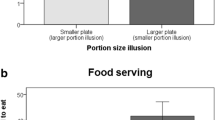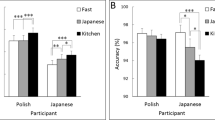Abstract
Due to growing globalization, there has been an increase in demand for ethnic or ethnic-flavored foods in the retail grocery and foodservice industries. However, some consumers are unlikely to enjoy ethnic or ethnic-flavored foods due to novelty or unfamiliarity associated with them. Limited research exists on consumer behavior toward ethnic or ethnic-flavored foods as a function of food neophobia. This study aimed to determine the influence of food neophobia on Caucasian consumers’ visual attention toward packaging images, as well as sensory acceptance of ethnic-flavored potato chips. Ninety adults were divided into high food neophobia (HFN) and low food neophobia (LFN) groups based on a food neophobia scale score. All participants’ visual attention toward packaging images of ethnic-, local-, and plain-flavored potato chips were measured using an eye-tracker, and their willingness to taste, expected liking, and purchase intent were assessed. One week later, the participants rated sensory perception and liking of the potato chip samples whose packaging images had been viewed. Participants in the LFN group looked significantly longer at the descriptions of ethnic (Chinese Szechuan) and local (Southern biscuits and gravy) flavors shown on the packaging images of potato chips than did those in the HFN group. As participants in the LFN group, but not those in the HFN group, looked at the descriptions of ethnic flavors shown on the packaging longer, they were more likely to like and purchase those potato chips. There were only limited impacts of food neophobia on attribute intensities and likings of the potato chips, irrespective of flavor. In conclusion, this study provides empirical evidence that participants with a lower level of food neophobia are more attentive to descriptions regarding ethnic flavor shown on packaging of chip products, possibly inducing a higher intent of purchasing the products, although such findings vary with the type of ethnic flavor.




Similar content being viewed by others
References
Arvola, A., Lähteenmäki, L., & Tuorila, H. (1999). Predicting the intent to purchase unfamiliar and familiar cheeses: The effects of attitudes, expected liking and food neophobia. Appetite, 32(1), 113–126.
Belasco, W. J. (1987). Ethnic fast foods: The corporate melting pot. Food and Foodways, 2, 1–30.
Burusnukul, P., Taylor, D. C., & Broz, C. (2015). Relationships of involvement, ethnic food consumption, and food shows: An initial exploration. International Journal of Hospitality & Tourism Systems, 8, 32–38.
Camarena, D. M., Sanjuán, A. I., & Philippidis, G. (2011). Influence of ethnocentrism and neo-phobia on ethnic food consumption in Spain. Appetite, 57, 121–130.
Carrington, M. J., Neville, B. A., & Whitwell, G. J. (2010). Why ethical consumers don’t walk their talk: Towards a framework for understanding the gap between the ethical purchase intentions and actual buying behavior of ethically minded consumers. Journal of Business Ethnics, 97, 139–158.
Choe, J. Y., & Cho, M. S. (2011). Food neophobia and willingness to try non-traditional foods for Koreans. Food Quality and Preference, 22, 671–677.
Dovey, T. M., Staples, P. A., Gibson, E. L., & Halford, J. C. (2008). Food neophobia and ‘picky/fussy’ eating in children: A review. Appetite, 50, 181–193.
Flight, I., Leppard, P., & Cox, D. N. (2003). Food neophobia and associations with cultural diversity and socio-economic status amongst rural and urban Australian adolescents. Appetite, 41, 51–59.
Guzek, D., Glabska, D., Lange, E., & Jezewska-Zychowicz, M. (2017). A Polish study on the influence of food neophobia in children (10–12 years old) on the intake of vegetables and fruits. Nutrients, 9, 563. https://doi.org/10.3390/nu9060563.
Huddleston, P., Behe, B., Minahan, S., & Fernandez, R. (2015). Seeking attention: An eye tracking study of in-store merchandise displays. International Journal of Retail & Distribution Management, 43, 561–574.
Jaeger, S. R., Rasmussen, M. A., & Prescott, J. (2017). Relationships between food neophobia and food intake and preferences: Findings from a sample of New Zealand adults. Appetite, 116, 410–422.
Juster, F. (1966). Consumer buying intentions and purchase probability: An experiment in survey design. Journal of American Statistical Association, 61, 658–696.
Meszaros, E. (2012). Research spotlight: Ethnic foods: Flying high. Retrieved July 30, 2017, from https://www.specialtyfood.com/news/article/research-spotlight-ethnic-foods-flying-high/.
Mustonen, S., Oerlemans, P., & Tuorila, H. (2012). Familiarity with and affective responses to foods in 8–11-year-old children. The role of food neophobia and parental education. Appetite, 58, 777–780.
National Restaurant Association. (2017). What’s hot: Top 10 food trends for 2017. News & Research. Retrieved July 30, 2017, from http://www.restaurant.org/News-Research/News/Whats-Hot-Top-10-food-trends-in-2017.
Plemmons, L. E., & Resurreccion, A. V. A. (1998). A warm-up sample improves reliability of responses in descriptive analysis. Journal of Sensory Studies, 13, 359–376.
Pliner, P., & Hobden, K. (1992). Development of a scale to measure the trait of food neophobia in humans. Appetite, 19, 105–120.
Rozin, P., & Fallon, A. (1980). The psychological categorization of foods and non-foods: A preliminary taxonomy of food rejections. Appetite, 1, 193–201.
Samant, S. S., & Seo, H. S. (2016). Effects of label understanding level on consumers’ visual attention toward sustainability and process-related label claims found on chicken meat products. Food Quality and Preference, 50, 48–56.
Schulze, G., & Watson, N. V. (1995). Comments on ‘Flavor neophobia in selected rodent species’. In R. Wong (Ed.), Biological perspectives on motivated activities (pp. 229–230). Norwood: Ablex Publishing Corporation.
Smith, A. D., Herle, M., Fildes, A., Cooke, L., Steinsbekk, S., & Llewellyn, C. H. (2017). Food fussiness and food neophobia share a common etiology in early childhood. Journal of Child Psychology and Psychiatry, 58, 189–196.
Solomon, M. R., Bamossy, G., Askegaard, S., & Hogg, M. K. (2013). Consumer behaviour: A European perspective (5th ed., pp. 134–135). Harlow: Pearson Education Ltd.
Ting, H., de Run, E. C., de Run, E. C., Cheah, J. H., Cheah, J. H., et al. (2016). Food neophobia and ethnic food consumption intention: An extension of the theory of planned behaviour. British Food Journal, 118, 2781–2797.
Tuorila, H., Lähteenmäki, L., Pohjalainen, L., & Lotti, L. (2001). Food neophobia among the Finns and related responses to familiar and unfamiliar foods. Food Quality and Preference, 12, 29–37.
Van Loo, E. J., Caputo, V., Nayga, R. M., Jr., Seo, H. S., Zhang, B., & Verbeke, W. (2015). Sustainability labels of coffee: Consumer preference, willingness-to-pay and visual attention to attributes. Ecological Economics, 118, 215–225.
Verbeke, W., & Poquiviqui López, G. (2005). Ethnic food attitudes and behaviour among Belgians and Hispanics living in Belgium. British Food Journal, 107, 823–840.
Zhang, B., & Seo, H. S. (2015). Visual attention toward food-item images can vary as a function of background saliency and culture: An eye-tracking study. Food Quality and Preference, 41, 172–179.
Author information
Authors and Affiliations
Corresponding author
Ethics declarations
Conflict of interest
The authors have declared that no conflict of interest exists.
Rights and permissions
About this article
Cite this article
Samant, S.S., Hanson, A.D., Asare, R. et al. Effects of food neophobia on visual attention and sensory acceptance of ethnic-flavored foods. Cult. Brain 6, 53–70 (2018). https://doi.org/10.1007/s40167-017-0057-8
Accepted:
Published:
Issue Date:
DOI: https://doi.org/10.1007/s40167-017-0057-8




